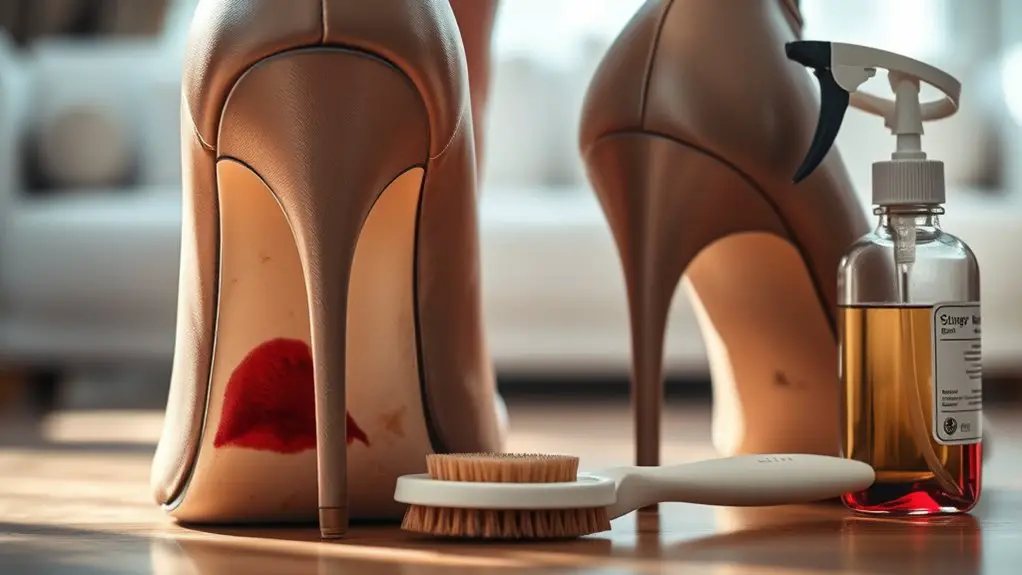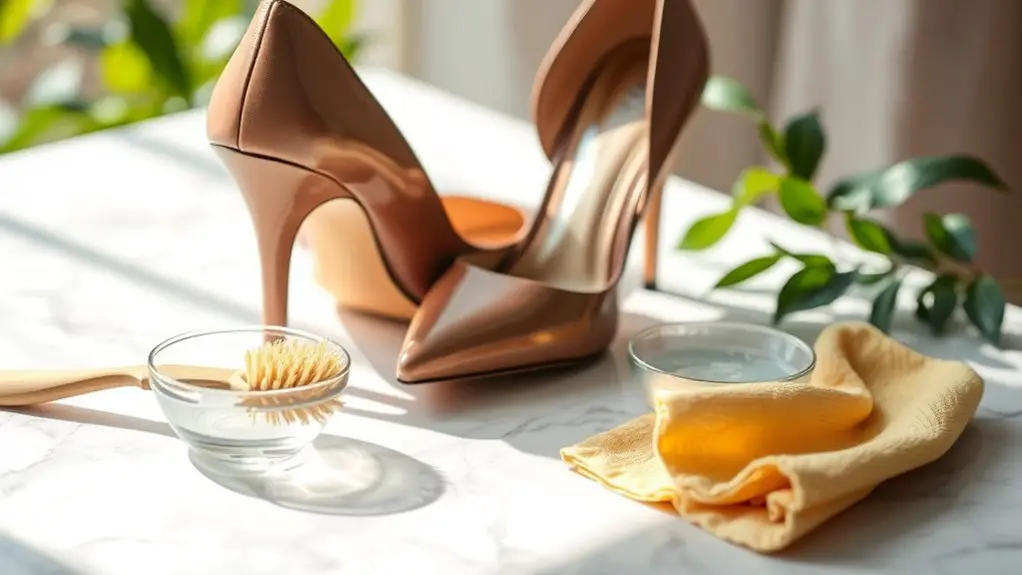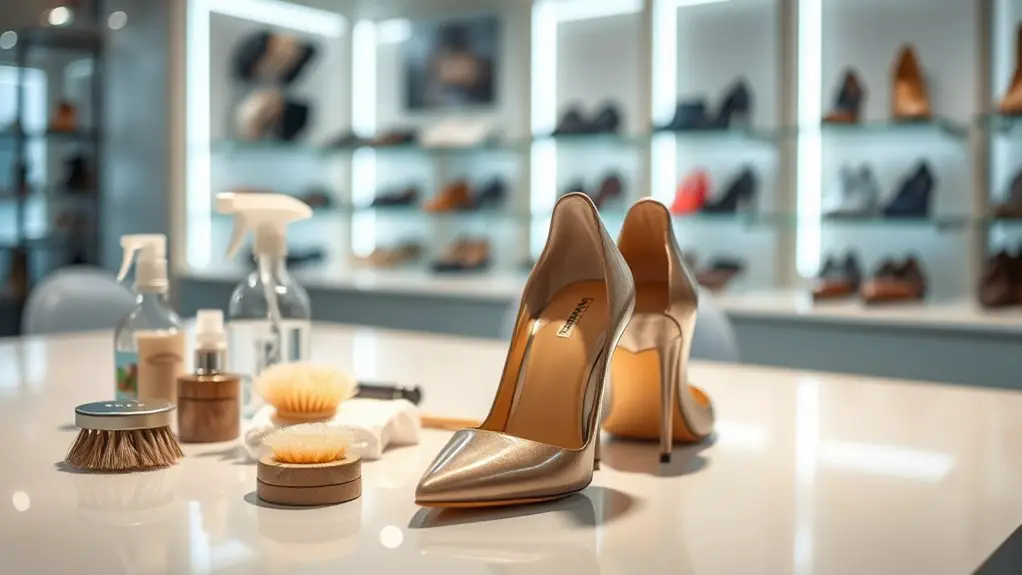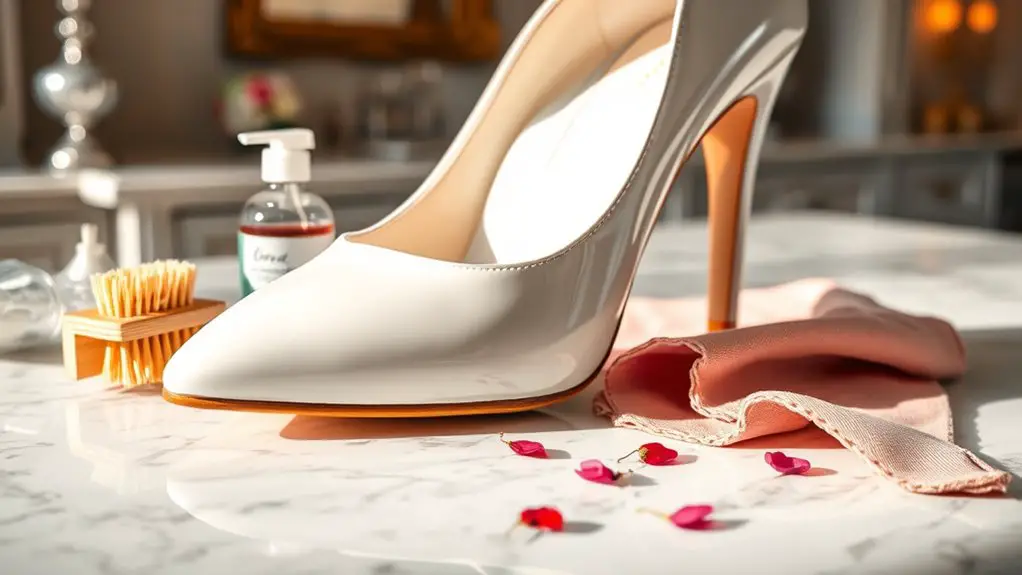To remove stains from your heels, start by identifying the stain type—be it oil, ink, or dirt. For minor marks, an eraser works wonders, while damp cloths and mild soap tackle dirt effectively. For deeper cleaning, use gentle cleaners suitable for your heel material, and always condition afterward. Prevent future stains by applying protective coatings and cleaning your heels regularly. If stains persist despite your efforts, there’s more to uncover about professional help and advanced techniques.
Identifying the Type of Stain

How can you effectively tackle stains on your heels? The first step is identifying the stain type, as different stains require different approaches. Common stain types include oil, ink, dirt, and food. Oil stains, for instance, can leave a dark mark that might require a solvent to dissolve, while ink stains often need a gentle approach with rubbing alcohol.
Next, consider the color effects of the stain. Light-colored heels show stains more prominently, while dark shades may mask them. However, this doesn’t mean they’re any less damaging. When tackling stains, always test your cleaning solution on a hidden area first to avoid discoloration. Knowing the stain type and understanding the potential color effects will help you choose the right method, ensuring your heels remain stylish and pristine. By taking these careful steps, you’ll protect your investment and keep your heels looking their best.
Quick Fixes for Minor Stains
While dealing with minor stains on your heels may feel challenging, there are several quick fixes you can employ to restore their appearance without extensive cleaning. For scuff marks, a simple eraser can work wonders; gently rub it over the stain and watch it disappear. For dirt or mud, a damp cloth paired with a small amount of mild soap can serve as an effective stain removal solution—just make sure to dry the area thoroughly afterward.
If you’ve got a grease stain, sprinkle a bit of cornstarch or baby powder on the affected area; let it sit for a few minutes before brushing it away. Finally, for fabric heels, a lint roller can be a stylish and quick solution for picking up minor debris. These quick solutions not only save time but also keep your favorite heels looking their best. Remember, prevention is key—avoid areas where stains are likely to occur!
Deep Cleaning Techniques

When it comes to deep cleaning your heels, employing the right techniques can make all the difference in restoring their pristine condition. Effective stain removal requires patience and the right cleaning products to tackle tougher blemishes. Here are some essential steps to evaluate:
- Choose the Right Cleaning Solution: Opt for a gentle cleaner suitable for your heel material, like leather or suede.
- Test First: Always test your cleaning product on a small, inconspicuous area to avoid damage.
- Use Soft Brushes: A soft-bristled brush can gently lift dirt and stains without scratching the surface.
- Condition Afterwards: After cleaning, apply a quality conditioner to keep your heels looking fresh and supple.
Preventative Measures for Future Stains
To keep your heels looking pristine, it’s essential to adopt preventative measures that minimize the risk of future stains. First, consider applying protective coatings specifically designed for your shoe material. These coatings act as a barrier, making it harder for dirt and spills to penetrate the surface. Additionally, regular maintenance can greatly assist in stain prevention.
| Action | Purpose | Frequency |
|---|---|---|
| Apply Protective Coating | Prevents stains and water damage | Every few months |
| Clean After Use | Removes surface dirt | After each wear |
| Store Properly | Avoids scuffs and marks | When not in use |
| Use Shoe Bags | Protects from dust and scratches | Always |
When to Seek Professional Help

Knowing when to seek professional help can save your beloved heels from irreversible damage. If you notice persistent stains that just won’t budge or if the material looks compromised, it’s essential to contemplate professional cleaning. Here are some indicators that it’s time to call in the experts:
- The stain has penetrated deep into the material, requiring specialized stain assessment to avoid further damage.
- You’ve tried multiple home remedies with no success, risking alteration to the shoe’s design.
- The material is delicate, like leather or suede, where DIY methods could lead to discoloration or texture changes.
- The heels have significant wear or tear, needing a professional touch for restoration.
Frequently Asked Questions
Can I Use Bleach to Remove Stains From My Heels?
Using bleach to remove stains from your heels isn’t always effective, especially on delicate materials. It’s essential to know the stain types first; some might require gentler, specialized cleaners to avoid damage.
How Can I Prevent Future Stains on My Heels?
Did you know that 70% of shoe stains come from everyday wear? To prevent future stains on your heels, consider preventive measures like regular maintenance tips, including protective sprays and gentle cleaning after each use.
Are There Specific Products for Different Materials?
Yes, there are specific products for different materials. For leather care, use specialized leather conditioners, while fabric cleaners are ideal for synthetic or fabric heels. Always test products on a small area first to guarantee compatibility.
What Should I Do if the Stain Persists?
If the stain persists, try alternative stain removal techniques like a vinegar solution or rubbing alcohol. Gently scrub with a soft cloth, and always test on a discreet area first to avoid damage.
Is It Safe to Use Vinegar on My Heels?
Using vinegar on your heels can be safe if diluted properly. Its benefits include breaking down stains and deodorizing. Just guarantee you follow up with proper heel care to maintain their elegance and longevity.



